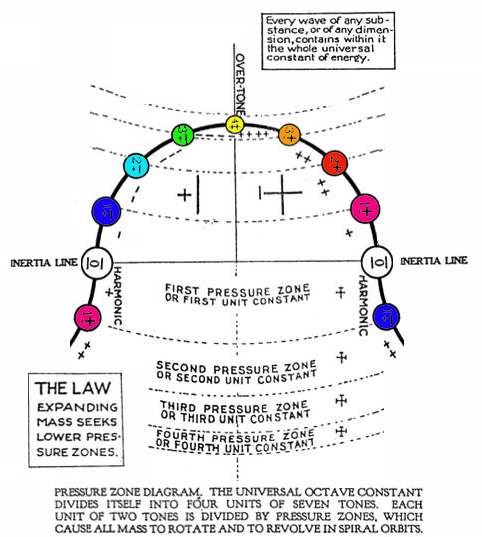
On harmonical parallel between tone and colour
—On the term of "rest," fifths, and the sympathy of music with life
—Relativities of sounds and vibrations of strings
—The doctrines of three pairs, six tones, and the law of "two and fro"
—The germ of the system probably to be found in the adaptability of numbers
—Sudden death of Dr. Gauntlett, . . . . . 48 [Harmonies of Tones and Colours, Table of Contents4 - Harmonies]
The twelve key-notes, with the six notes of each as they veer round in trinities, are again written in musical clef, and the scales added. The key-note leads the scale, and, after striking the two next highest notes of the seven of the harmony, goes forward, with its four lowest, an octave higher. The seven of each harmony have been traced as the three lowest, thus meeting the three highest in three pairs, the fourth note being isolated. Notwithstanding the curious reversal of the three and four of the scale, the three lowest pair with the three highest, and the fourth with its octave. The four pairs are written at the end of each line, and it will be seen how exactly they all agree in their mode of development. Keys with sharps and keys with flats are all mingled in twelve successive notes. If we strike the twelve scales ascending as they follow each other, each thirteenth note being octave of the first note of the twelve that have developed, and first of the rising series, the seventh time the scales gradually rise into the higher series of seven octaves beyond the power of the instrument. Descending is ascending reversed. After the seven and octave of a scale have been sounded ascending, the ear seems to lead to the descending; but ten notes of any scale may be struck without the necessity of modulation; at the seventh note we find that the eleventh note in the progression of harmonics rises to meet the seventh. For instance, B, the seventh note in the scale of C, must have F#. This point will be fully entered into when examining the meeting of fifths. To trace the scale of C veering round as an example for all, we may begin with C in Diagram II., and go forward with F, G, A, and B an octave higher. If the twelve scales were traced veering round, they would be found to correspond with the twelve as written in musical clef. [Harmonies of Tones and Colours, Diagram IV - The Development of the Twelve Major Scales, page 26a]
See Also
11.13 - Dominant Conditions are Mated Opposing Pairs as Fifths
bidirectional wave pair
carbon pair
centripetal pair
complementary pair
complementary pairs
cooper pair
divided and extended pairs
divided electric pairs
divided pairs
doctrine of three pair and six tones
electrically divided pair of moving lights
Father-Mother
Figure 15.05 - Nine Pairs of Gravity Poles
Figure 2.1.5 - Russells Rings forming Spheres from Three Pairs of Reflecting Mirrors
five pairs
four pairs of cones
four pairs of projecting rings
four pairs of tones
four pairs
mate-pairs
moving pairs
octave pairs of rings
octave pairs
pair of fifths
pair of gravity points
pair of points
pair
pairs of gravity points
pairs of opposition
pairs of ring units
pairs of spinning rings
pairs of tones
polarity
projected light of spectrum pairs
seven pairing
sex-conditioned pairs
sexed pairs
six tones
thirteen pairs
three pairs
trinity in unity
unit pairs
united fourth pair
united pair
united pairs of rings
universal division of sexed pairs
wave pair
